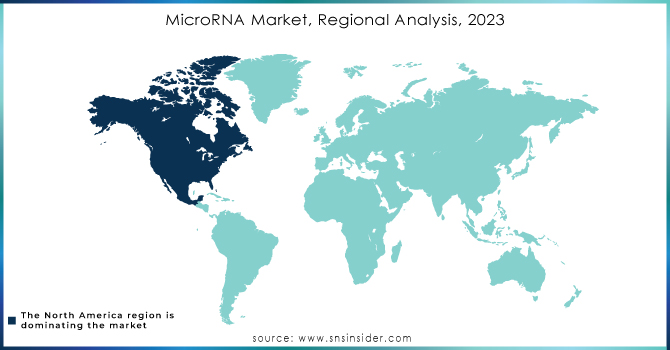MicroRNA Market Size & Trends

Get More Information on microRNA Market - Request Sample Report
The MicroRNA Market Size was USD 1.3 Billion in 2023 and is expected to Reach USD 7.7 Billion by 2032 and grow at a CAGR of 21.1% over the forecast period of 2024-2032.
The market size in the global market for microRNA, or miRNA, is significant as the instances of diseases like cancer, cardiovascular conditions, and neurological disorders have been constantly growing. Such illnesses require advanced and agile types of diagnostics and treatment, and the functions of miRNAs can control gene expression and serve as non-invasive biomarkers; therefore, the introduction of diagnostics involving miRNAs, especially those related to cancer, has only hastened developments in precision medicine with additional applications comprising potential utility to address critical healthcare challenges.
There is significant innovation in the market whereby firms in this industry continue to develop new and innovative technologies, formulations of products as well as methods of delivery. The stability of circulating miRNAs in bodily fluids including serum and plasma particularly in exosomes has offered new avenues for their application in diagnosis and prognosis, as well as enhancing their market presence. Thermo Fisher Scientific and Pfizer have strengthened collaborations and partnerships among top leaders in advancing the rollout of complex miRNA-based testing in underserved regions, hence contributing to market growth in the global arena.
The growth in the market is propelled by mergers and acquisitions, wherein companies like Merck KGaA, QIAGEN, and Thermo Fisher are expanding their geographic reach and product portfolios. Such activities enable the market players to advance into new regions, exploit emerging opportunities, and meet diverse healthcare demands that position the miRNA market for continued expansion across the regions.
MicroRNA Market Dynamics
Drivers
- Rising Clinical Trials for Chronic Disease Treatment Propel miRNA Market Growth
Evidence derived from these increasing clinical trials in chronic diseases and even further rising research that is constantly developing the clinical and preclinical use of miRNAs enhances the evidence that may be derived from such molecules as modulators of drug resistance, pathogenic biomarkers, and even therapeutic agents in various health-related issues. Increasing interest in miRNAs in a clinical setting enlightens one on the role of miRNAs in enhancing diagnostics and treatment results of a wide spectrum of chronic diseases.
Rapid surges in clinical studies examining the potential of miRNAs in the treatment of diseases, such as cancer, cardiovascular diseases, and neurological disorders, are driving market expansion. The importance of miRNAs has been demonstrated as they can control disease development and have proven to be valuable non-invasive biomarkers to be a cornerstone in developing new therapies.
The ever-increasing number of clinical trials is making the drug development and development of medical interventions based on miRNA a promising offer. The trend has the potential to drive forward the market scope in miRNA and to be used as a source for the advancement of therapy and improvement in patients for managing chronic diseases.
Restraints
- Safety and Toxicity Concerns May Hinder miRNA Market Growth
As promising as miRNA might seem for clinical applications; particularly in chronic diseases such as cancer, cardiovascular disorders, and renal conditions, there stands a challenge due to issues of its safety and toxicity being matters of concern. It led to the suspension of several clinical trials intended to determine new miRNA-based therapies. As can be seen, Mirna Therapeutics, Inc., a clinical-stage pharmaceutical company, recently announced the discontinuation of its Phase 1 trial on MRX34, an experimental treatment for several types of cancers. According to this, "several patients in this ongoing Phase 1 trial have experienced severe immune-related adverse events, and further enrollment and dosing are being held pending assessment of these observations.
MicroRNA Market Segmentation Analysis
By Product And Services
In 2023, the service segment led the market with the highest revenue share of 58.8%. The service segment can be further divided into services including isolation & purification, miRNA cDNA synthesis, profiling, localization & quantification, functional analysis, and others. Some of the additional services target prediction and validation also support the growth of the segment. For example, an article in Nature published in January 2023 reported identifying plant-specific miRNA targets that were accurately predicted by P-TarPmiR. According to the article, the removal of animal data from the model resulted in better accuracy for the prediction of plant miRNA targets. The article further stated that animal data may interfere with a particular prediction of plant data. In the case of soybean genome-based miRNA targets, all of them were predicted successfully by the P-TarPmiR approach.
Meanwhile, the product segment is expected to experience significant growth during the forecast period. For this reason, this growth happens foremost in the increased application of miRNA as biomarkers for disease diagnosis and the increasing number of firms engaged in consumables such as kits and reagents for the study of miRNA expression.
By Application
Revenue share by segment in 2023 was led by the cancer segment because of huge investments in cancer research in the context of miRNA signatures. It further supports revenue dominance through clinical trials of miRNA-based therapies and diagnostic tests that aim at the subtypes and stages of cancer differentiation. miRNA diagnostics offer an improved approach to the diagnosis of certain types of cancer but are also considered a possible breakthrough in identifying cancers of unidentified origin.
The infectious disease segment is expected to grow at the highest CAGR during the forecast period. miRNAs are increasingly recognized as reliable biomarkers for various human diseases due to their crucial role in regulating gene expression at the post-transcriptional level. These factors are key contributors to the segment's growth. The infectious disease segment also witnessed a humongous growth spurt during the COVID-19 pandemic based on the significantly increased demand for miRNA research in viral diagnostics.
By End-User
The biotechnology and pharmaceutical companies segment led the market in 2023, primarily because they play an important role in establishing partnerships and collaborations with research institutions. Access through such partnerships brings the companies closer to discovering the latest cutting-edge research and allows them to take large-scale projects forward, thereby accelerating and enhancing the development of miRNA technology. For example, in the middle of August 2022, the Singapore biotechnology company, MiRXES, unveiled new capabilities that include an i4.0 manufacturing facility and two more laboratories; additionally, it announced a research project for the development of a multitalented screening test to detect cancer in collaboration with whomsoever. All the above initiatives are lining up to enhance its research and production capabilities aimed at developing miRNA-based detection tests.
The academic and government research institutes segment is likely to experience high growth in the forecast period. miRNA techniques and related products are increasingly being applied to various research studies conducted by academic and research institutions. This growing number of studies will further propel this market growth. For instance, in October 2022, researchers at the Institute of Science in Varanasi's School of Biotechnology found a microRNA that selectively kills and destroys cervical cancer cells. Research work based on this observation may eventually help come up with non-invasive cervical cancer therapy using microRNA therapy.
MicroRNA Market Regional Outlook
North America held the largest market share in 2023, driven by the strong local presence of key industry players such as Thermo Fisher Scientific, NanoString Technologies, Inc., and Merck KGaA. The region's miRNA market growth is attributed to a surge in research and development investments by these companies to create innovative and advanced products.
In the U.S., which accounted for the largest share of the North American market, major players like Thermo Fisher Scientific, Merck KGaA, and QIAGEN have well-established distribution networks, ensuring the easy availability of miRNA products and services. These companies maintain a strong emphasis on research and development, providing cutting-edge technological support to their customers. For instance, in August 2021, researchers at the Texas Heart Institute made breakthroughs in understanding disease through miRNA profiling, highlighting the crucial role of miRNAs in gene regulation and disease pathogenesis.
The Asia Pacific region is anticipated to witness the fastest growth during the forecast period. Factors such as a large target population, rapid adoption of new technologies, a rising number of startups, and a developing healthcare infrastructure contribute to this expansion. In China, the largest revenue contributor in the Asia Pacific market in 2023, increasing focus on precision medicine and the high potential of miRNAs in its development is expected to drive growth. Additionally, organizations such as the National Science Foundation and the National Nature Science Foundation are providing significant support for omics research. These entities promote collaborations between traditional Chinese knowledge and modern scientific advancements, with ongoing studies exploring the role of miRNAs in conjunction with traditional Chinese medicines like herbs.

Get Customized Report as per Your Business Requirement - Request For Customized Report
Key Players
-
QIAGEN
-
New England Biolabs
-
Quantabio
-
Horizon Discovery Group plc.
-
NanoString Technologies, Inc.
-
Merck KGaA
-
Takara Bio, Inc.
-
LGC Limited
-
BioGenex
-
GeneCopoeia, Inc.
-
New England Biolabs
-
Heim Biotek
-
SeqMatic LLC
-
Miltenyi Biotec
-
Sistemic Scotland Limited
-
Biodynamics Laboratory Inc.
-
OriGene Tec
-
Synlogic
Recent Developments
In October 2023, Thermo Fisher Scientific announced plans to invest USD 3.1 billion to acquire Olink Holding AB, aiming to expand its life sciences portfolio and enhance its capabilities in drug discovery.
In November 2023, QIAGEN launched new QIAcuity digital PCR kits and upgraded software, designed to help biopharma and food safety clients optimize and broaden their applications.
| Report Attributes | Details |
| Market Size in 2023 | US$ 1.3 Billion |
| Market Size by 2032 | US$ 7.7 Billion |
| CAGR | CAGR of 21.1% From 2024 to 2032 |
| Base Year | 2023 |
| Forecast Period | 2024-2032 |
| Historical Data | 2020-2022 |
| Report Scope & Coverage | Market Size, Segments Analysis, Competitive Landscape, Regional Analysis, DROC & SWOT Analysis, Forecast Outlook |
| Key Segments |
|
| Regional Analysis/Coverage | North America (US, Canada, Mexico), Europe (Eastern Europe [Poland, Romania, Hungary, Turkey, Rest of Eastern Europe] Western Europe] Germany, France, UK, Italy, Spain, Netherlands, Switzerland, Austria, Rest of Western Europe]), Asia Pacific (China, India, Japan, South Korea, Vietnam, Singapore, Australia, Rest of Asia Pacific), Middle East & Africa (Middle East [UAE, Egypt, Saudi Arabia, Qatar, Rest of Middle East], Africa [Nigeria, South Africa, Rest of Africa], Latin America (Brazil, Argentina, Colombia, Rest of Latin America) |
| Company Profiles | Thermo Fisher Scientific, Inc., QIAGEN, New England Biolabs, Quantabio, Horizon Discovery Group plc., NanoString Technologies, Inc., Merck KGaA, Takara Bio, Inc., LGC Limited, BioGenex, GeneCopoeia, Inc. and Other Players |
| Key Drivers | • Rising Clinical Trials for Chronic Disease Treatment Propel miRNA Market Growth |
| Market Restraints | • Safety and Toxicity Concerns May Hinder miRNA Market Growth |

